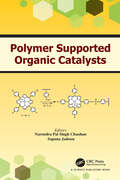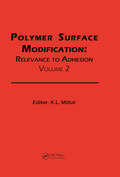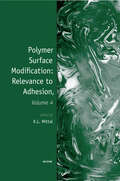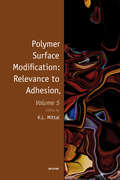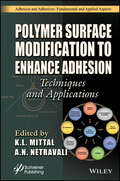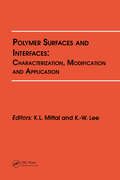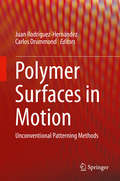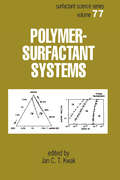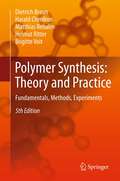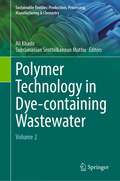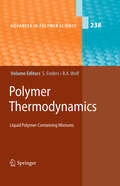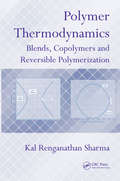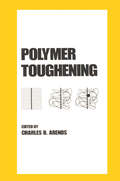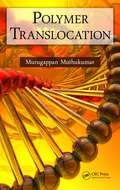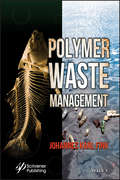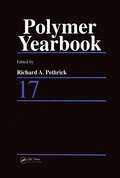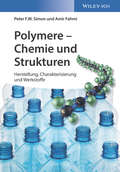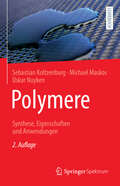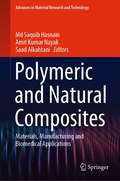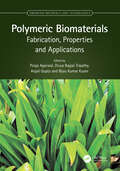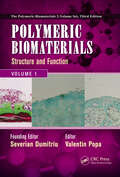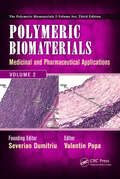- Table View
- List View
Polymer Supported Organic Catalysts
by Narendra Pal Singh Chauhan Sapana JadounPolymer-supported organic catalysts are largely insoluble in most reaction solvents, which allows for easy recovery and recycling of the catalysts. They are generally stable, readily available, and environmental friendly, so they have attracted the interest of many synthetic chemists in the industrial and academic fields. In this book, different types of polymer-supported catalysts based on peptides, polystyrene, polyethers, poly(acrylic acid), poly(ethylene imine), poly(2-oxazoline), poly(isobutylene), poly(norbornene), etc., as well as metals are included with their synthetic organic synthesis applications.It is believed that this work will be of interest to organic chemists, material scientists, chemical engineers, polymer scientists and technologists.
Polymer Surface Modification: Relevance To Adhesion
by K. L. MittalThis book chronicles the proceedings of the Second International Symposium on Polymer Surface Modification: Relevance to Adhesion held Newark, New Jersey, May 24--26, 1999. Polymeric materials are intrinsically not very adhesionable and this necessitates their surface treatment to enhance their adhesion characteristics to other materials. Since the first symposium on this topic, held in 1993, there has been a tremendous R&D activity in devising novel or ameliorating the existing techniques for surface modification of polymers. This volume contains a total of 32 papers, which have been rigorously peer-reviewed and suitably revised before inclusion in this volume. The book is divided into three parts as follows. Part 1: Plasma Surface Modification Techniques; Part 2: Other/Miscellaneous Surface Modification Techniques; and Part 3: General Papers. The topics covered include: plasma surface modification of a variety of polymers using various plasma gases; atmospheric plasma system; surface functionalization; ultrahydrophobic polymeric surfaces; metallization of plasma treated polymers; surface modification of polymers via molecular design for adhesion promotion; wet chemical methods for polymer surface modification; laser surface modification of various polymers; UV/ozone treatment; surface and interface studies of treated polymer surfaces by an array of techniques; bioadhesion of polymeric biomaterials to tissue; polymer-fiber systems; and plasma deposited coatings.
Polymer Surface Modification: Relevance to Adhesion, Volume 4
by Kash L. MittalThis book documents the proceedings of the Fifth International Symposium on this topic, held in Toronto. The book is divided into two parts: Part 1: Surface Modification Techniques; Part 2: Adhesion Improvement to Polymer Surfaces.Various ways to modify a host of polymer surfaces for a variety of purposes are covered in this book, with emphasis on
Polymer Surface Modification: Relevance to Adhesion, Volume 5
by Kash L. MittalThe topic of polymer surface modification is of tremendous contemporary interest because of its critical importance in many and varied technological applications where polymers are used. Currently there is brisk research activity in unraveling the mechanisms of surface modification and finding ways to prolong the life of surface treatment. Also the
Polymer Surface Modification to Enhance Adhesion: Techniques and Applications
by K. L. Mittal A. N. NetravaliPOLYMER SURFACE MODIFICATION TO ENHANCE ADHESION This unique, comprehensive and groundbreaking book is the first on this important subject. Polymer Surface Modification to Enhance Adhesion comprises 13 chapters and is divided into two parts: Part 1: Energetic Treatments; and Part 2: Chemical Treatments. Topics covered include atmospheric pressure plasma treatment of polymers to enhance adhesion; corona treatment of polymer surfaces to enhance adhesion; flame surface treatment of polymers to enhance adhesion; vacuum UV photo-oxidation of polymer surfaces to enhance adhesion; optimization of adhesion of polymers using photochemical surface modification UV/Ozone surface treatment of polymers to enhance adhesion; adhesion enhancement of polymer surfaces by ion beam treatment; polymer surface modification by charged particles; laser surface modification of polymeric materials; competition in adhesion between polysort and monosort functionalized polyolefinic surfaces; amine-terminated dendritic materials for polymer surface modification; arginine-glycine-aspartic acid (RGD) modification of polymer surfaces; and adhesion promoters for polymer surfaces. Audience The book will be of great interest to polymer scientists, surface scientists, adhesionists, materials scientists, plastics engineers, and to those involved in adhesive bonding, packaging, printing, painting, metallization, biological adhesion, biomedical devices, and polymer composites.
Polymer Surfaces and Interfaces: Characterization, Modification and Application
by K. L. Mittal K. W. LeePolymeric materials are used for a legion of applications in a wide array of technological areas, and their proper surface/interface characteristics are of cardinal importance for their applications. Therefore, the need to characterize polymer surfaces/interfaces and their suitable modification to impart desired characteristics is quite patent. This book chronicles the proceedings of the Symposium on Polymer Surfaces and Interfaces: Characterization, Modification and Application held as a part of the Society of Plastics Engineers Annual Technical Conference, Boston, May 7--11, 1995. The articles in this book address many aspects of polymer surfaces and interfaces. Topics covered include: various ways (chemical, photochemical, laser, flame, corona) to modify polymer surfaces; modification of contact lens surfaces; various ways to analyze/characterize polymer surfaces; metal/polymer interfaces; metal/polyimide adhesion; metal/self-assembled organic monolayer interfaces; polymer alignment layers for liquid crystals; alignment of liquid crystal surfaces; polyimide alignment layers; molecular re-orientation of polymer surfaces; plasma polymerized organic coatings; epoxy/fiber interphase; epoxy underfill materials for packaging integrated circuits; transport in polymers; polymer miscibility; and cell adhesion.
Polymer Surfaces in Motion
by Juan Rodríguez-Hernández Carlos DrummondPattern formation is a fascinating and challenging aspect in polymer science. This book describes a number of unconventional approaches developed to control the morphology of polymer surfaces and materials, from random or simple patterns to complex structures. Specialists provide an up-to-date and complete overview of each technique in their respective field.
Polymer-Surfactant Systems (Surfactant Science Ser.)
by Jan C. T. Kwak"Chronicles recent advances in our knowledge of polymer-surfactant systems, combining authoritative reviews of new experimental methods, instrumentation, and applications with fundamental discussions of classical methodologies and surveys of specific properties."
Polymer Synthesis: Fundamentals, Methods, Experiments
by Matthias Rehahn Brigitte Voit Helmut Ritter Harald Cherdron Dietrich BraunEmphasis is on a broad description of the general methods and processes for the synthesis, modification and characterization of macromolecules. These more fundamental chapters will be supplemented by selected and detailed experiments. In addition to the preparative aspects the book also gives the reader an impression on the relation of chemical constitution and morphology of Polymers to their properties, as well as on their application areas. Thus, an additional textbook will not be needed in order to understand the experiments. The 5th edition contains numerous changes: In recent years, so-called functional polymers which have special electrical, electronic, optical and biological properties, have gained more and more in interest. This textbook was therefore supplemented by recipes which describe the synthesis of these materials in a new chapter "Functional polymers". Together with new experiments in chapter 3,4 and 5 the book now contains more than 120 recipes that describe a wide range of macromolecules. From the reviews of recent editions: "This is an excellent book for all polymer chemists engaged in synthesis research studies and education. It is educationally sound and has excellent laboratory synthetic examples. The fundamentals are well done for the teaching of students and references are resonably up-to-date. As in previous issues, there are sections dealing with an introduction; structure and nomenclature; methods and techniques for synthesis, characterization, processing and modification of polymers. ....The authors have noted the following changes from previous editions- a new section on correlations of structure, morphology and properties; revision and enlargement of other property and characterization procedures; additional new experiments such as controlled radical polymerization; enzymatic polymerizations; microelmulsions; and electrical conducting polymers. This is a high quality textbook at a reasonable price and should be considered as a suitable reference for all engaged in synthetic areas of polymer research." (Eli M. Pearce, Polytechnic University, Brooklyn, NY, USA)
Polymer Technology in Dye-containing Wastewater: Volume 2 (Sustainable Textiles: Production, Processing, Manufacturing & Chemistry)
by Ali Khadir Subramanian Senthilkannan MuthuThe textile industry is among the most significant polluters of water owing to the existence of various types of pollution streams generated by printing processes and textile dyeing. The book begins by documenting various types of Poly (vinyl alcohol) PVA-derived adsorbents (gels, fibers, films, composite particles), membranes, and photocatalysts in combination with conventional adsorbents, polymers, carbonaceous and metallic materials and their use in elimination of dyes from contaminated water. It follows by discussing different properties of nanocomposite membranes such as hydrogels, xerogels and aerogels used in this purpose. Also, different polymer – based adsorbents such as ceramic adsorbent, clay, hydrogels, starch, cellulose, chitosan, alginates, etc are presented in this book.
Polymer Technology in Dye-containing Wastewater: Volume 1 (Sustainable Textiles: Production, Processing, Manufacturing & Chemistry)
by Ali Khadir Subramanian Senthilkannan MuthuDyes are versatile compounds that have been successfully used in textile printing, rubber, cosmetics, plastic, pharmaceutical, and leather industries to color the products. Dye-using industries, particularly textile or printing industries are responsible for the generation of a great amount of colored wastewater that are polluting and threatening the environment. Many of these dyes are carcinogenic, mutagenic, and teratogenic, as well as harmful to human, aquatic life, and other living things and their elimination from wastewater is highly essential. Various approaches have been implemented in the efforts to mitigate the issue related to textile wastewater, such as adsorption, biological processes, advanced oxidation processes, membrane technology, etc. In this Volume 1, the application of various types of polymers in different wastewater treatment technologies are presented. The synthesis procedure of some polymers, the polymer modification, the effect of operational parameters on polymer efficiency, the interactions between polymers – dyes, etc are discussed.
Polymer Thermodynamics
by Sabine Enders Bernhard A. WolfMaking Flory-Huggins Practical: Thermodynamics of Polymer-Containing Mixtures, by B. A. Wolf * Aqueous Solutions of Polyelectrolytes: Vapor-Liquid Equilibrium and Some Related Properties, by G. Maurer, S. Lammertz, and L. Ninni Schäfer * Gas-Polymer Interactions: Key Thermodynamic Data and Thermophysical Properties, by J.-P. E. Grolier, and S. A.E. Boyer * Interfacial Tension in Binary Polymer Blends and the Effects of Copolymers as Emulsifying Agents, by S. H. Anastasiadis * Theory of Random Copolymer Fractionation in Columns, by Sabine Enders * Computer Simulations and Coarse-Grained Molecular Models Predicting the Equation of State of Polymer Solutions, by K. Binder, B. Mognetti, W. Paul, P. Virnau, and L. Yelash * Modeling of Polymer Phase Equilibria Using Equations of State, by G. Sadowski
Polymer Thermodynamics: Blends, Copolymers and Reversible Polymerization
by Kal Renganathan SharmaPolymer Thermodynamics: Blends, Copolymers and Reversible Polymerization describes the thermodynamic basis for miscibility as well as the mathematical models used to predict the compositional window of miscibility and construct temperature versus volume-fraction phase diagrams. The book covers the binary interaction model, the solubility parameter
Polymer Toughening
by Charles B. ArendsThis work provides comprehensive coverage of the basic theories and hands-on techniques of polymer toughening, demonstrating the similarities in methods of measurement and toughness enhancement found in various classes of polymeric materials, including foams, films, adhesives and moulding grade polymers. It provides a detailed overview, from historical and current points of view, of polymer toughening as practiced in industry, and lays the theoretical groundwork for the analysis and prediction of different modes of toughening.
Polymer Translocation
by M. MuthukumarPolymer translocation occurs in many biological and biotechnological phenomena where electrically charged polymer molecules move through narrow spaces in crowded environments. Unraveling the rich phenomenology of polymer translocation requires a grasp of modern concepts of polymer physics and polyelectrolyte behavior. Polymer Translocation discusse
Polymer Viscoelasticity: Stress and Strain in Practice (Plastics Engineering)
by Evaristo RiandeShowcasing vital engineering applications to transient and dynamic pertubations of macromolecular materials, structural recovery's role in mechanical responses in the glassy state, and viscoelastic parameters that condition the non-Newtonian behaviour of polymers, this work presents a systematic account of the responses of macromolecular materials
Polymer Waste Management
by Johannes Karl FinkWith the huge amount of plastics floating in the oceans, fish and other sea creatures are directly suffering the consequences. On land, city leaders and planners are banning one-use plastics as well as plastic bags from grocery stores in an effort to stem the use. Many countries have made official announcements and warnings concerning the pollution caused from plastic wastes. These urgent developments have stimulated the author to study the problem and write Polymer Waste Management. Plastic recycling refers to a method that retrieves the original plastic material. However, there are many sophisticated methods available for the treatment and management of waste plastics such as basic primary recycling, where the materials are sorted and collected individually. In chemical recycling, the monomers and related compounds are processed by special chemical treatments. Other methods, such as pyrolysis, can produce fuels from waste plastics. These methods and others are treated comprehensively in the book This ground-breaking book also discusses: General aspects, such as amount of plastics production, types of waste plastics, analysis procedures for identification of waste plastic types, standards for waste treatment, contaminants in recycled plastics. Environmental aspects, such as pollution in the marine environment and landfills. The advantages of the use of bio-based plastics. Recycling methods for individual plastic types and special catalysts.
Polymer Yearbook 13
by Richard. A. Pethrick Gennadi Zaikov Teiji Tsuruta Naoyuki KoidePolymer Yearbook 13 brings together reviews and information on the progress of polymer science worldwide, including useful and topical information such as a list of new publications in polymer science and a compilation of dissertation abstracts. This volume includes reviews of key aspects of polymer science, including contributions from Russia, and details of important publications., This volume also contains reviews on state-of-the-art Japanese research presented at the annual Spring and Fall meetings of the Japanese Polymer Science Society. The aim of this section is to make information on the progress of Japanese polymer science, and on topics of current interest to polymer scientists in Japan, more easily available worldwide.
Polymer Yearbook 17
by Richard A. Pethrick Gennadi E. Zaikov Naoyuki Koi DeThis volume contains reviews on state-of-the-art Japanese research presented in the annual Spring and Autumn meetings of the Japanese Polymer Science Society. The aim of this section is to make information on the progress of Japanese Polymer Science , and on topics of current interest to polymer scientists in Japan, more easily available worldwide.
Polymere - Chemie und Strukturen: Herstellung, Charakterisierung und Werkstoffe (Verdammt clever!)
by Peter F. Simon Amir FahmiZu den Polymeren gehören allgegenwärtige Kunststoffe wie Plexiglas, Dichtmassen, Klebestreifen und viele Verpackungsmaterialien. Daher bildet die Vermittlung der Grundlagen polymerer Werkstoffe einen integralen Bestandteil der Curricula der Studienfächer Chemie, Materialwissenschaften und der Ingenieur- und Lebenswissenschaften. Dieses Buch ermöglicht einen leichten Einstieg in die Polymerwissenschaften. Die Polymerklassen Thermoplaste, Duroplaste und Elastomere werden mit ihren Eigenschaften vorgestellt, und den Studierenden wird vermittelt, welche Synthesestrategie zu dem Produkt mit den gewünschten Eigenschaften führt. Die am häufigsten verwendeten Polymere werden anhand alltagsbezogener Beispiele eingeführt. Zahlreiche Tipps und Übungsaufgaben unterstützen beim Lernen.
Polymere: Synthese, Eigenschaften und Anwendungen
by Sebastian Koltzenburg Michael Maskos Oskar NuykenAusgezeichnet mit dem Literaturpreis des VCIPolymere sind einzigartige Moleküle und weisen Eigenschaften auf wie keine andere Materialklasse auf dieser Welt. Sie begegnen uns im täglichen Leben nicht nur in Form der bekannten, großvolumigen Kunststoffe wie PE oder PP oder der vielen weiteren, zum Teil hochgradig angepassten Spezialpolymere, sondern auch in der Natur als polymere Biomoleküle wie beispielsweise DNA. Unser Leben wäre daher so, wie wir es kennen, ohne Makromoleküle nicht nur vollkommen anders, sondern biologisch gar nicht möglich.Dieses Lehrbuch beschäftigt sich daher umfassend mit der Synthese, der Charakterisierung, den Eigenschaften und den Anwendungen von Polymeren. Ziel ist es, breite Kenntnisse der Grundbegriffe der makromolekularen Chemie und der einzigartigen Eigenschaften dieser Verbindungsklasse zu vermitteln. Auch umweltrelevante Themen wie Biopolymere und Mikroplastik, die in einem zeitgemäßen Lehrbuch nicht fehlen dürfen,werden behandelt.Aufbauend auf den Grundkenntnissen der organischen Chemie und der Thermodynamik präsentiert das Buch ein leicht verständliches und dennoch tiefgehendes Bild dieser sehr dynamischen und immer wichtiger werdenden Wissenschaft in der Schnittmenge von Chemie, Physik, Ingenieurwissenschaften und dem Life-Science-Sektor. Das Verständnis des Textes können Leserinnen und Leser dieses Werkes am Ende eines jeden Kapitels durch eine Auswahl an Übungsaufgaben überprüfen.Beim Verfassen des Buches wurde großer Wert auf gute Lesbarkeit trotz der erforderlichen Detailtiefe gelegt – ein Buch, das sich für Studierende der Chemie und verwandter Studiengänge genauso eignet wie für den angewandten Naturwissenschaftler im industriellen Umfeld. Als erstes und bisher einziges Lehrbuch der Polymerchemie wurde daher bereits die erste Auflage dieses Werks 2015 mit dem Literaturpreis des Fonds des Verbandes der Chemischen Industrie ausgezeichnet.
Polymeric and Natural Composites: Materials, Manufacturing and Biomedical Applications (Advances in Material Research and Technology)
by Md Saquib Hasnain Amit Kumar Nayak Saad AlkahtaniThis book provides understanding of raw materials, manufacturing and biomedical applications of different polymeric and natural composites such as drug delivery, growth factor delivery, orthopedics, dentistry and wound dressing.
Polymeric Biomaterials: Fabrication, Properties and Applications (Emerging Materials and Technologies)
by Pooja Agarwal Divya Bajpai Tripathy Anjali Gupta Bijoy Kumar KuanrBiomaterials include a versatile group of molecules that have been designed to interact with biological systems for various applications and polymeric biomaterials are being designed based on their availability and compatibility. This book summarizes fabrication techniques, features, usage, and promising applications of polymeric biomaterials in diversified areas including advantageous industrial applications. Each chapter exclusively covers a distinct application associated with major classes of polymeric biomaterials. Features: Provides platform related to fabrication and advancement of all categories of polymeric biomaterials Explores advancement of pertinent biomedical and drug delivery systems Includes wide range of biomaterials and its application in diversified fields Gives out environmental justification of green biopolymers and their applications in water remediation Discusses advanced applications of bio-composite polymers viz. food packaging and anti-corrosive coatings This book is aimed at researchers in Polymer Sciences, Biomaterials, Chemical/Bio Engineering, Materials Chemistry, and Biotechnology.
Polymeric Biomaterials: Structure and Function, Volume 1
by Severian Dumitriu Valentin PopaBiomaterials have had a major impact on the practice of contemporary medicine and patient care. Growing into a major interdisciplinary effort involving chemists, biologists, engineers, and physicians, biomaterials development has enabled the creation of high-quality devices, implants, and drug carriers with greater biocompatibility and biofunctiona
Polymeric Biomaterials: Medicinal and Pharmaceutical Applications, Volume 2
by Severian Dumitriu Valentin PopaBiomaterials have had a major impact on the practice of contemporary medicine and patient care. Growing into a major interdisciplinary effort involving chemists, biologists, engineers, and physicians, biomaterials development has enabled the creation of high-quality devices, implants, and drug carriers with greater biocompatibility and biofunctiona
